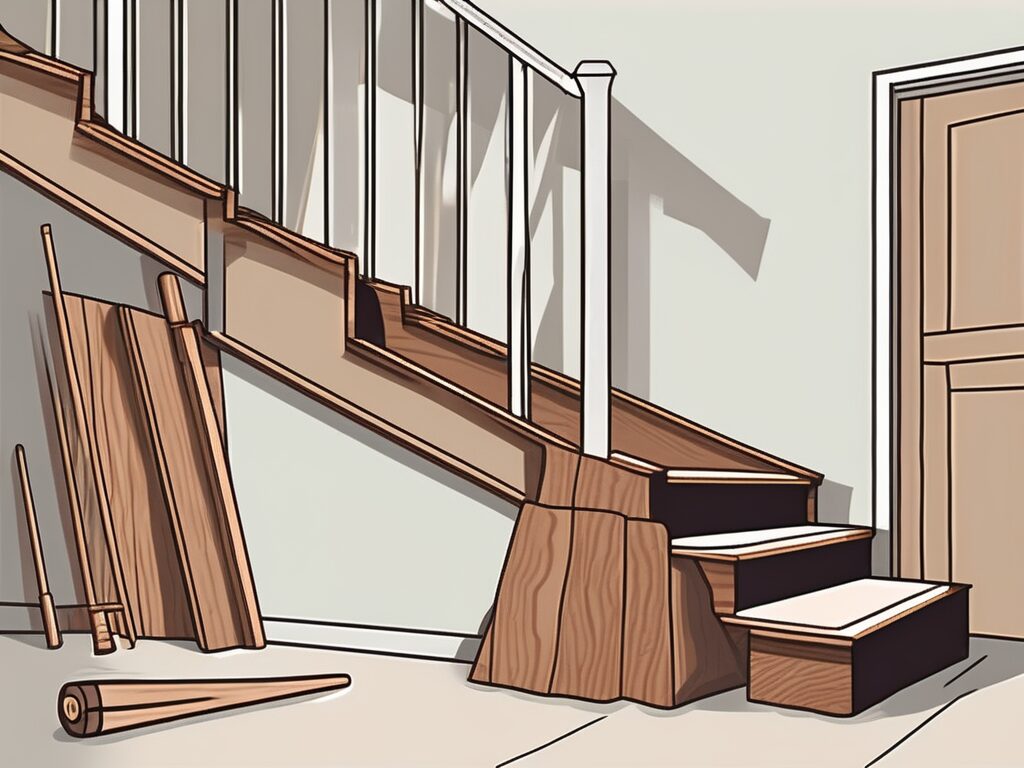
Agent A-Team or Solo Superhero? Finding the Right Real Estate Partner for Your Selling Journey in Wildwood Florida
When it comes to selling your home in Wildwood, Florida,…
January 29, 2024
If you’ve been dreaming of upgrading your carpeted stairs to beautiful, timeless wood, you’re not alone. Converting carpeted stairs to wood is a popular project that can completely transform the look and feel of your home. In this ultimate guide, we’ll break down the costs involved and provide you with step-by-step instructions to successfully complete the conversion yourself.
Before diving into the conversion process, it’s essential to understand the expenses involved. By having a clear idea of the costs, you can plan your budget accordingly and avoid any surprises along the way.
The cost of converting carpeted stairs to wood will vary depending on several factors. These factors include the size of your staircase, the type of wood you choose, and whether you decide to take on the project yourself or hire a professional.
On average, the cost of materials for this project ranges from $500 to $2,000. This includes the cost of wood treads and risers, adhesives, nails, and any additional tools or materials needed. Keep in mind that if you hire a professional contractor, the labor costs will be an additional expense.
Let’s delve deeper into the different expenses you may encounter during the conversion process:
1. Size of the Staircase: The size of your staircase plays a significant role in determining the overall cost. Larger staircases will require more materials, resulting in higher expenses. Additionally, if your staircase has unique features or intricate designs, it may require additional labor and specialized tools, which can further increase the cost.
2. Type of Wood: The type of wood you choose for your stairs will also impact the cost. Different types of wood have varying prices, with hardwoods generally being more expensive than softwoods. Additionally, exotic woods or custom finishes may come at a premium, adding to the overall expenses.
3. DIY vs. Professional Installation: Deciding whether to tackle the project yourself or hire a professional can significantly affect the cost. While DIY may seem cost-effective initially, it’s important to consider your skill level and the time and effort required. If you’re not experienced in carpentry, you may end up making costly mistakes or spending more on tools. Hiring a professional ensures a high-quality finish but comes with additional labor costs.
4. Additional Costs: Apart from the main materials, there are other potential expenses to consider. These may include sanding and finishing supplies, paint or stain, and any necessary repairs or modifications to the existing staircase structure. It’s crucial to account for these additional costs to avoid any budgetary surprises.
By taking these factors into account, you can develop a comprehensive understanding of the expenses involved in converting carpeted stairs to wood. Remember, budgeting for the project is crucial to ensure a smooth and successful renovation process.
Converting carpeted stairs to wood is a significant DIY project that requires careful planning and execution. To achieve a successful outcome, follow this step-by-step guide to ensure nothing is overlooked.
Undertaking a DIY staircase project can be a rewarding and transformative experience for any homeowner. Not only does it add value to your home, but it also enhances the overall aesthetic appeal. However, before you embark on this journey, it is crucial to have a well-thought-out plan in place and gather all the necessary tools and materials.
The first step in converting carpeted stairs to wood is to create a detailed plan of action. Measure your stairs, calculate the number of treads and risers you’ll need, and decide on the type of wood that will best suit your home’s aesthetic.
When choosing the type of wood, consider factors such as durability, grain pattern, and color. Hardwoods like oak, maple, or walnut are popular choices due to their strength and timeless appeal.
Next, gather all the necessary tools and materials. This includes a circular saw, hammer, pry bar, tape measure, wood glue, and sandpaper. Having everything on hand before you begin will save you valuable time and keep the project on track.
Before you can start transforming your carpeted stairs, make sure you have all the tools and materials you need. This includes:
Having these essentials will ensure a smooth workflow and prevent unnecessary delays during the project.
The next step is removing the carpet and preparing the stairs for the wood transformation. Start by carefully pulling up the carpet and padding, being mindful of any tacks or staples that may be present.
As you remove the carpet, take a moment to appreciate the hidden potential beneath. You may discover beautiful hardwood waiting to be revealed or a blank canvas ready for your creative touch.
Once the carpet is removed, inspect the stairs for any damage. Repair any loose or creaky steps and ensure the surface is clean and smooth before moving forward.
With the stairs prepped, it’s time to cut and install the new wood treads and risers. Measure each step carefully and use a circular saw to cut the wood to the correct dimensions.
As you cut the wood, take a moment to appreciate the craftsmanship involved in creating each individual piece. The precision and attention to detail required to ensure a perfect fit is a testament to the artistry of woodworking.
Apply wood glue to the back of each tread and riser, then press firmly into place. Secure with nails or screws if necessary, and repeat the process for each step.
Once the treads and risers are in place, it’s time to add the finishing touch with a beautiful stain. Choose a stain color that complements your home’s overall aesthetic and enhances the natural beauty of the wood.
As you apply the stain, watch in awe as the wood absorbs the rich pigments, bringing out its unique characteristics. Each brushstroke is a stroke of artistry, adding depth and warmth to your staircase.
Apply the stain evenly across each tread and riser, following the manufacturer’s instructions. Allow the stain to fully dry before applying a protective coat of clear sealer.
By following this comprehensive guide, you’ll be well on your way to transforming your carpeted stairs into a stunning wooden staircase that will be the envy of all who enter your home.
While converting carpeted stairs to wood can be a rewarding DIY project, there are times when it’s best to bring in the professionals. Hiring an experienced contractor can save you time, ensure a high-quality result, and provide expert guidance throughout the process.
Converting carpeted stairs to wood is not a task to be taken lightly. It requires careful planning, precise measurements, and a keen eye for detail. While some homeowners may feel confident in their ability to tackle this project on their own, there are several factors to consider before diving in headfirst.
One of the main reasons to bring in the professionals is the time-saving aspect. Converting carpeted stairs to wood is a time-consuming process that requires patience and precision. A professional contractor will have the necessary tools and expertise to complete the project efficiently, allowing you to enjoy your new wood staircase sooner.
Another advantage of hiring a professional is the assurance of a high-quality result. Converting carpeted stairs to wood involves intricate carpentry work, including cutting, sanding, and fitting each individual step. A professional contractor will have the skills and experience to ensure that every step is perfectly crafted and installed, resulting in a flawless finished product.
When selecting a contractor for your staircase renovation, it’s crucial to do your research. Look for professionals with experience in stair conversions and read customer reviews or ask for referrals.
Request multiple quotes and compare the services offered. A reputable contractor will provide a detailed breakdown of the costs involved and communicate clearly throughout the project. This transparency is essential to ensure that there are no hidden fees or surprises along the way.
Furthermore, it’s important to choose a contractor who understands your vision and can bring it to life. A skilled professional will take the time to listen to your ideas, provide valuable input, and work collaboratively with you to create a staircase that matches your style and complements your home’s aesthetic.
Working with a professional contractor allows you to benefit from their expertise in design choices. They can help you select the right wood species, stain color, and overall design elements that will enhance the beauty of your home.
With their knowledge of current trends and timeless designs, a professional contractor can guide you in making informed decisions that will stand the test of time. They can also provide samples and visual representations of different design options, allowing you to see how each choice will look in your space before making a final decision.
A professional contractor will have the necessary skills and tools to ensure the project stays on schedule. They can tackle any challenges that arise and help you avoid common pitfalls that could lead to delays in completing your staircase renovation.
From coordinating the delivery of materials to managing subcontractors, a professional contractor will take care of all the logistical aspects of the project, allowing you to focus on other priorities in your life. This level of organization and efficiency is invaluable, especially if you have a tight timeline or are working on multiple home improvement projects simultaneously.
Converting carpeted stairs to wood may involve tricky details, such as curved or angled steps. Professionals have the experience and skill to handle these complexities and create a seamless and visually stunning staircase transformation.
They understand the intricacies of working with different wood species and can expertly shape each step to fit the unique contours of your staircase. Whether it’s a sweeping spiral staircase or a set of narrow, winding steps, a professional contractor will ensure that every detail is meticulously executed, resulting in a cohesive and visually striking finished product.
In some cases, accessing the staircase may be challenging due to limited space or obstructions. Professional contractors have the know-how to overcome these access issues and ensure a successful conversion, even in the most difficult spaces.
They will carefully assess the layout of your home and develop a plan that minimizes disruption to your daily life. Whether it involves removing doors, temporarily relocating furniture, or using specialized equipment, a professional contractor will find creative solutions to ensure a smooth and seamless staircase transformation.
Staircase renovations must meet safety standards and building codes. A professional contractor will ensure that your conversion meets all necessary requirements, providing you with peace of mind and a safe staircase for years to come.
They will take into account factors such as handrail height, tread depth, and riser height to ensure that your staircase is not only visually appealing but also safe and comfortable to use. By entrusting your staircase renovation to a professional, you can rest assured that every aspect of the project will be executed with precision and in compliance with all relevant regulations.
Converting carpeted stairs to wood can be a rewarding project that adds value and beauty to your home. Whether you choose to take on the challenge yourself or hire a professional, this ultimate guide provides you with the information you need to embark on a successful staircase renovation. With careful planning, attention to detail, and a bit of creativity, you’ll soon have a stunning wood staircase that will be the envy of all who enter your home.

If you want the Richr team to help you save thousands on your home just book a call.
 Book a call
Book a call